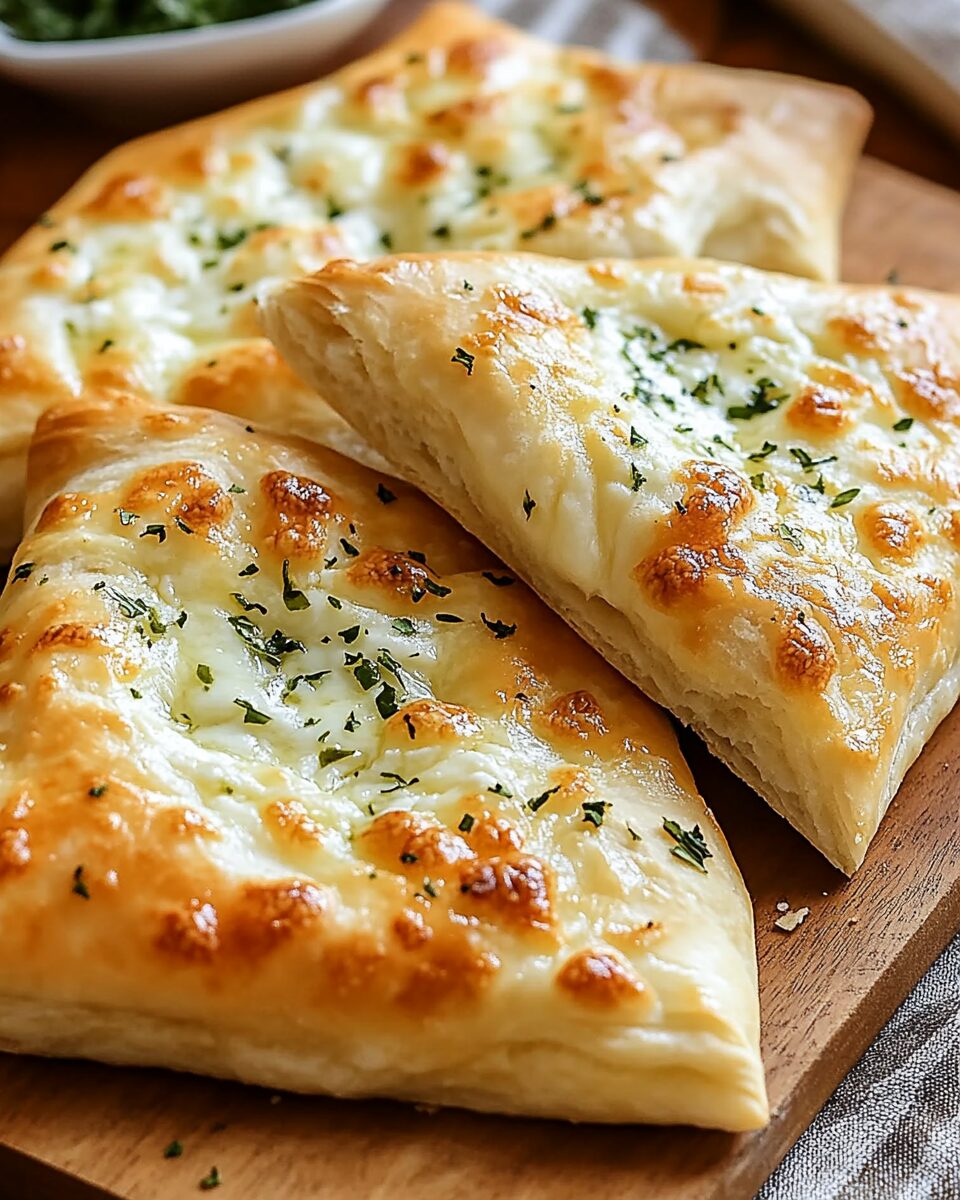Cheese Fatayer are savory Middle Eastern pastries filled with a rich mixture of feta, mozzarella, and fresh herbs, all encased in soft, golden dough. These triangular pockets are crispy on the outside, melty on the inside, and make the perfect snack, appetizer, or brunch option. With their delicious filling and flaky texture, they’re a crowd-pleasing favorite that’s fun to make and even better to eat.
Full Recipe:
Ingredients
For the Dough:
-
2 cups all-purpose flour
-
1 tsp instant yeast
-
1 tsp sugar
-
½ tsp salt
-
3 tbsp olive oil
-
¾ cup warm water (adjust as needed)
For the Cheese Filling:
-
1 cup feta cheese, crumbled
-
1 cup mozzarella cheese, shredded
-
2 tbsp parsley, chopped
-
1 tbsp mint, chopped
-
1 tsp lemon zest
-
Salt and pepper, to taste
For the Egg Wash:
-
1 egg, beaten
-
1 tbsp water
Directions
1. Make the Dough
Combine warm water, yeast, and sugar. Let sit until frothy.
In a bowl, mix flour and salt, then stir in yeast mixture and olive oil.
Knead on a floured surface for 5–7 minutes until smooth.
Place in a greased bowl, cover, and let rise for 30 minutes.
2. Prepare Filling
Mix feta, mozzarella, parsley, mint, lemon zest, salt, and pepper in a bowl.
3. Assemble the Fatayer
Preheat oven to 375°F (190°C). Line a baking sheet with parchment.
Divide risen dough into 16 balls. Roll each into a 4-inch circle.
Add a tablespoon of cheese filling to each center.
Fold into a triangle and pinch the edges tightly.
Place on baking sheet and brush with egg wash.
4. Bake
Bake for 12–15 minutes until golden brown.
Cool slightly before serving.
Nutrients
-
Calories: ~200–250 per fatayer
-
Protein: 8g
-
Carbohydrates: 20g
-
Fat: 14g
A Taste of Levantine Tradition
Fatayer (فطاير) are part of a wider family of Middle Eastern savory pastries that have been passed down through generations, especially in Levantine countries like Lebanon, Syria, Jordan, and Palestine. Though spinach and meat fillings are also common, cheese-filled versions are universally loved for their simplicity and indulgent taste. They are traditionally served as mezze, alongside hummus, labneh, olives, and flatbread. Making fatayer from scratch is a cultural ritual, often involving multiple family members gathering to prepare dough, mix fillings, and assemble pastries by hand—a culinary tradition that’s as much about connection as it is about the food itself.
What Makes Cheese Fatayer So Special
The real magic of Cheese Fatayer lies in the interplay of textures and flavors. The dough is soft and pliable, becoming slightly crisp and golden when baked. Inside, the filling offers a delightful blend of salty feta, creamy mozzarella, and bright, herbaceous notes from parsley, mint, and lemon zest. This combination provides a savory, rich, and slightly tangy profile that feels both refreshing and indulgent. Unlike overly greasy pastries, these bake up light yet satisfying, making them a go-to choice for snacks, party platters, or breakfast treats.
The Importance of a Good Dough
A soft, elastic dough is the foundation of a successful fatayer. This particular recipe uses all-purpose flour, olive oil, and instant yeast for a dough that’s easy to work with and produces consistently tender results. Letting the dough rest and rise ensures it’s light and airy, yet strong enough to hold the filling without tearing. The olive oil adds moisture and richness, while a touch of sugar activates the yeast and balances the savory notes of the cheese. Rolling each piece into uniform discs helps achieve even baking, while the triangular shape makes for easy sealing and a traditional look.
The Flavorful Filling
While the dough is important, the filling is the true star. The combination of feta and mozzarella strikes the perfect balance—feta contributes its sharp, salty tang, while mozzarella provides the stretchy, melty quality that defines comfort food. Fresh parsley and mint lift the flavor with bright herbal notes, and lemon zest adds a subtle citrusy edge that cuts through the richness. A pinch of salt and pepper fine-tunes the balance, though be cautious with salt—feta itself brings a naturally briny punch. You can also experiment with other herbs like dill or thyme for a personalized twist.
Why They’re Great for Any Occasion
Cheese Fatayer are wonderfully versatile. They’re the ideal finger food for brunches, potlucks, and dinner parties, and they pair beautifully with dips like tzatziki, baba ghanoush, or tomato chutney. They’re easy to pack for picnics, school lunches, or road trips. Best of all, they freeze well and can be made in advance—perfect for prepping meals ahead of time or stocking your freezer with ready-to-bake snacks. With their appealing shape and approachable flavor, they’re also a fantastic way to introduce kids to international cuisine.
Health and Nutrition Notes
While pastries are generally seen as indulgent, Cheese Fatayer can be a nutritious choice when made with fresh, whole ingredients. Each fatayer contains around 200–250 calories, 8 grams of protein, and a healthy balance of carbohydrates and fats. Using olive oil instead of butter keeps the fat content heart-healthy, and the cheeses offer calcium and protein. If you include herbs like parsley and mint, you add antioxidants and micronutrients as well. For a lighter option, you can reduce the cheese or use part-skim mozzarella and low-fat feta. Whole wheat flour can also be substituted for part of the all-purpose flour to increase fiber content.
Make-Ahead and Freezing Tips
Fatayer are excellent for meal prepping and storing. Once assembled, they can be frozen unbaked on a tray until firm, then transferred to freezer bags for up to three months. To bake from frozen, simply brush with egg wash and bake as directed, adding a few extra minutes to the baking time. Baked fatayer can also be stored in the fridge for 3–4 days and reheated in the oven or toaster oven until warm and crisp. This makes them an ideal grab-and-go option for breakfast, snacks, or quick lunches.
Tips for Shaping Perfect Triangles
Forming the fatayer into their signature triangular shape may seem tricky at first, but a few simple tips ensure success:
-
Roll each dough ball into a uniform 4-inch circle.
-
Place the filling in the center and fold three edges toward the center to form a triangle.
-
Pinch the seams firmly and use a bit of water on your fingertips to seal the edges.
-
Avoid overfilling to prevent bursting during baking.
Once you get the hang of it, shaping the fatayer becomes a fun and rewarding part of the process—great for getting kids or guests involved in the kitchen.
Serving Ideas and Pairings
Cheese Fatayer shine on their own, but they’re even better when served as part of a larger Middle Eastern spread. Pair them with:
-
A bowl of olives or pickled vegetables for a salty contrast.
-
Fresh mint tea or yogurt drinks for cooling refreshment.
-
A plate of hummus or labneh, which complements the creamy filling.
-
A simple chopped cucumber-tomato salad with lemon and olive oil for freshness.
They’re also great with a drizzle of hot honey or pomegranate molasses for a sweet-savory finish that contrasts beautifully with the salty cheese.
Conclusion
Cheese Fatayer are the kind of dish that brings joy to the table—flaky, cheesy, herby, and perfectly satisfying. Rooted in tradition but endlessly adaptable, they’re a testament to how simple ingredients can create something truly special. Whether you’re serving them as an appetizer, packing them for lunch, or baking a batch for your next brunch spread, these pastries are sure to win hearts. With their golden crust, melty center, and irresistible flavor, Cheese Fatayer deliver comfort, culture, and craftsmanship in every bite. Once you make them at home, they’ll quickly become a treasured favorite in your kitchen rotation.








